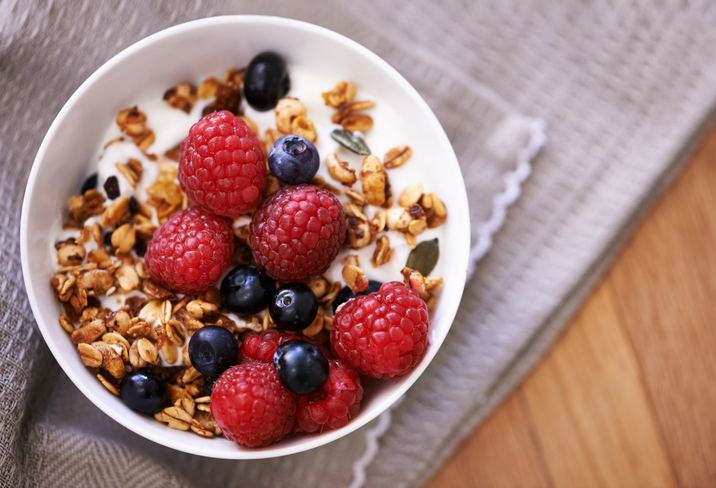Fibre is essential for your gut to work normally. It increases good bacteria which supports your immunity against inflammatory disorders and allergies. A high fibre diet seems to reduce the risk of chronic diseases such as cardiovascular disease, type 2 diabetes and bowel cancer.
What is it?
Dietary fibre is the part of plants that you eat but which doesn't get digested in your small intestine. Instead, it is completely or partially broken down (fermented) by bacteria in your large intestine. Fibre includes carbohydrates called polysaccharides and resistant oligosaccharides (ROS).

Recent research suggests that fibre should be categorised by its physical characteristics; how well it dissolves (solubility), how thick it is (viscosity) and how well it breaks down (fermentability). Some commonly known terms are described below:
- Soluble fibre including pectins and beta glucans is found in foods like fruit and oats.
- Insoluble fibre including cellulose is found in wheat bran and nuts.
- Resistant starch (RS) is a soluble fibre that is highly fermentable in the gut. It gets broken down by good bacteria to produce short chain fatty acids (SCFAs). RS is naturally present in some foods such as bananas, potatoes, grains and pulses.
- Prebiotics are types of carbohydrate that only our gut bacteria can feed upon. Some examples are onions, garlic, asparagus and banana (see the BDA food fact sheet on Probiotics and prebiotics).
Why is fibre important?
Once broken down in your large intestine, it has been suggested that dietary fibres increase the beneficial bacteria in your gut. This improves your immune system.
Eating a range of dietary fibre can:
- Improve the diversity of your microbiota
- Improve constipation and lactose intolerance
- Enhance immunity
- Reduce inflammation in your gut
For example, high quality randomised controlled trials have shown that eating oat bran leads to lower blood pressure and lower total cholesterol.
You may wish to see a dietitian if you:
- are unsure about how much and/or what types of fibre you currently have in your diet
- suffer with constipation or diarrhoea (e.g. irritable bowel syndrome (IBS))
- have a condition which can restrict your fibre intake (e.g. inflammatory bowel disease)
How can I eat with this in mind?
Choose fibre rich foods from a variety of sources including wholegrains, fruit and vegetables, nuts and seeds, beans and pulses. When you read food labels, check for the grams of fibre per serving or per 100g.
What are you looking for on a nutrition label?
| High fibre | Source of fibre |
| 6g per 100g | 3g or more per 100g |
How much fibre should I have?
Adults are recommended to get around 30g of dietary fibre each day for the general health benefits.
However, the latest figures suggest that in the UK, the average fibre intake for adults is 18g, 60% of what it should be.
Children from age two should aim for 15g per day. Primary school age children should try to eat 20g per day. Secondary school aged children should try to eat 25g per day.
This advice should be adapted according to your medical history and tolerance level. If you have conditions such as IBS, you may find fermentable fibre in larger amounts causes bloating, gas and diarrhoea (see our BDA Food Fact Sheet on IBS).
Some of the best fibre rich food choices are:
|
Total fibre per 100g* |
|
|
Cereals and Carbohydrates |
|
|
Shredded whole wheat or bran cereals |
13-24.5g |
|
Wholemeal bread (two slices) |
7.0g |
|
Wholemeal spaghetti (boiled) |
4.2g |
|
Fruit and Vegetables |
|
| Figs |
6.9g |
|
Strawberries |
3.8g |
|
Parsnip (boiled) |
4.7g |
|
Broccoli (boiled) |
2.8g |
|
Nuts and seeds |
|
|
Almonds |
7.4g |
| Peanuts |
7.6g |
|
Sesame |
7.9g |
|
Sunflower seeds |
6.0g |
|
Peas and beans |
|
|
Peas (boiled) |
5.6g |
|
Baked beans (in tomato sauce) |
4.9g |
|
Green beans (boiled) |
4.1g |
*Based on American Association of Analytical Chemists (AOAC) or non-starch polysaccharides (NSP) if measurements not available
There are many ways you can increase your fibre intake:
Add
- fruit, nuts and seeds to breakfast cereal
- linseeds into yogurt
- extra vegetables and pulses, such as lentils, into sauces for bolognese, curry and chilli
- chunky peanut butter to some apple slices or celery sticks
Swap
- white flour for wholegrain wheat flour when baking
- white bread and pasta for wholemeal options
- white crackers for carrot or celery sticks to have with hummus
Try to
- keep a supply of frozen vegetables so you are never without
- leave the skin on vegetables and fruit
- have five portions of fruit and vegetables each day
- remember to drink a good amount of fluid as you increase your fibre
As suggested, there are lots of ways to increase the amount of fibre in your diet. An example menu is provided below which shows how you can get at least the recommended 30g of fibre in a day (for an adult).
Breakfast
|
Overnight oats |
Portion size |
Fibre per portion |
|
Raw porridge oats |
50g |
4g |
|
Frozen raspberries |
50g |
1.3g |
|
Plain yoghurt/milk |
100g |
|
|
Nut topping (walnuts/ almonds) |
40-50g |
4g |
Lunch
|
Filled baked potato |
Portion size |
Fibre per portion |
|
Baked potato |
180g – medium cooked |
5g |
|
Baked beans |
80g |
3g |
|
Sweetcorn (tinned) |
80g |
2g |
Dinner
|
Mediterranean spaghetti |
Portion size |
Fibre per portion |
|
Wholemeal spaghetti with pesto |
150g |
6g |
|
Broccoli and cherry tomatoes |
80g |
2g |
Snacks
|
Snacks |
Portion size |
Fibre per portion |
|
Wholemeal bread toasted with peanut butter |
2 slices 1 tablespoon |
7g 1g |
|
A banana or apple |
1 medium sized |
2g |
TOTAL: approx 38g
Top tips
- Dietary fibre provides many health benefits, for people of all ages.
- You may wish to improve your fibre intake if you suffer from constipation.
- If you increase your fibre intake, do it gradually to avoid gastrointestinal symptoms such as bloating and gas, and allow your gut to adjust to the higher intake.
- There are different types of fibre and they can have different effects in your gut.
- See a dietitian if you have concerns about increasing your fibre intake.
- Look on ingredient labels for foods high in fibre (6g per 100g) or that are considered a source of fibre (3g or more per 100g).
- At your next meal time, try to incorporate some new vegetables and grains into your existing dishes.
- Swap staple items like bread, pasta and flours from white to wholegrain/wholemeal.
- Remember to drink plenty of fluid to allow the fibre to do its job properly. Fibre draws water into the bowel so you may become dehydrated if you do not drink enough.
- Check out our Food Fact Sheets on prebiotics, wholegrains and IBS for more info.
Source(s)
- British Nutrition Foundation [Internet]. Nutrition.org.uk. 2021 [cited 14 April 2021]. Available from: https://www.nutrition.org.uk/
- Gill, S.K., Rossi, M., Bajka, B. et al. Dietary fibre in gastrointestinal health and disease. Nat Rev Gastroenterol Hepatol 18, 101–116 (2021). https://doi.org/10.1038/s41575-020-00375-4
- Lomax AR, Calder PC. Prebiotics, immune function, infection and inflammation: a review of the evidence. Br J Nutr. 2008:1–26.
- McCance and Widdowson’s 'composition of foods integrated dataset' on the nutrient content of the UK food supply. [Internet]. GOV.UK. 2021 [cited 14 April 2021]. Available from: https://www.gov.uk/government/publications/composition-of-foods-integrated-dataset-cofid
- PEN: Practice-based Evidence in Nutrition [Internet]. Pennutrition.com. 2021 [cited 14 April 2021]. Available from: https://www.pennutrition.com/index.aspx
- SACN Carbohydrates and Health Report [Internet]. GOV.UK. 2021 [cited 14 April 2021]. Available from: https://www.gov.uk/government/publications/sacn-carbohydrates-and-health-report
- Williams, B. A., Mikkelsen, D., Flanagan, B. M., & Gidley, M. J. (2019). "Dietary fibre": moving beyond the "soluble/insoluble" classification for monogastric nutrition, with an emphasis on humans and pigs. Journal of animal science and biotechnology, 10, 45. https://doi.org/10.1186/s40104-019-0350-9







